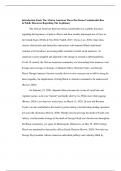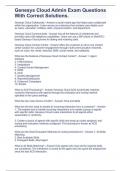Introduction Study The African American There Has Beena Considerable Rise
in Public Discourse Regarding The Legitimacy
The African American there has beena considerable rise in public discourse
regarding the legitimacy of police officers and their racially disparaged use of force in
the United States (Wolfe & Nix 2016; Fridell, 2017; Torres et al., 2018). Since then,
various other hostile and fatal police interactions with unarmed Black individuals
continue to be broadcast, increasing public attention towards racial injustices. As
American society grappled and adjusted to the change in normalcy global pandemic
Covid-19 curated, the African American community was also reeling from immense viral
footage and coverage of slayings of Ahmaud Arbery, Breonna Taylor, and George
Floyd. Though America's historic racially divisive roots were proven to still be strong by
these tragedies, the implications of being Black in America continued to be underscored
(Brown, 2020).
On February 23, 2020, Ahmaud Arbery became the victim of racial hate and
vigilante justice, as he was “hunted” and fatally shot by two White men while jogging
(Brown, 2020). Less than two weeks later, on March 13, 2020, 26-year-old Breonna
Taylor was shot and killed in her home by police during a botched drug-dealing operation
in Louisville, Kentucky (Brown, 2020). Months into the grieving the death of Taylor and
Arbery, viral bystander footage of the death of George Floyd sent shockwaves throughout
the Black community, yet again. In Minneapolis, Minnesota, on May 25, 2020, George
Floyd was murdered by then-police officer Derek Chauvin (Brown, 2020). Not only was
George Floyd another African American individual publicly and violently killed by
,police, but how his death occurred was horrendous. For nine minutes and 29 seconds,
Derek Chauvin kneeled on the neck of a handcuffed Floyd as three other officers assisted
and prevented any health aid intervention. Floyd's health visibly declined within the
almost 10 minutes of fatal and unnecessary use of force, yet Chauvin still refused to
remove his knee from the pleading restrained Floyd. Milliseconds before the halfway
mark of 9 minutes, paramedics arrived, and Derek Chauvin finally relieved the pressure
from George Floyd's neck, but this was nonbeneficial. Floyd was pronounced dead at the
scene.
The deaths of Arbery, Taylor, and Floyd added fuel to the already blazing
national outrage of racial injustices and subsequent local and federal police reform
initiatives and demonstrations that resulted from similar police-involved killings of
unarmed Black individuals. Their deaths echoed parallel treatment and phrases "I can't
breathe" seen and heard during the 2014 deaths of Michael Brown and Eric Gardner,
which ignited the initial spark in discourse. However, these similarities also highlight the
minimal progress made in how African Americans are treated by most institutions in
America (Brown, 2020). Since 2013, American society has responded with heightened
emotion to the murders of unarmed Black individuals and many are frustrated with the
lack of change. Individuals are caught at an “inflection point” of societal priorities and
forced to choose between pro-police and pro-Black lives; wedged in the middle of this
debate are African American police officers.
As attention to the widespread divisive discourse of negating and creating
mutually exclusive political and social issues of justice, equity, equality, over pro-police
,and pro-Black lives rights and protections, the perceived expectations of African
American officers potentially curate distress. During increased public cynicism toward
police, African American officers are expected to perform their professional front-line
duties and stand in solidarity with their fellow officers. Though, they are still and can be a
victim of the law by these same “brothers in blue,” off duty and face rejection of the
African American community (Paul & Birzer, 2017). The overarching demands,
expectations, and vulnerability of the African American police officer since Michael
Brown's death contribute to the development of role strain and overload as they overlook
the implications of race and professional role responsibilities.
Existing research indicates highly publicized volatile police interactions with
persons of color or mega-threats produce negative emotional responses and future work
behavior and self-concept changes in African Americans (Leigh & Melwani, 2019). As a
result, double consciousness and marginality experiences among African American
officers intensify (Dukes, 2018; Kochel, 2020; Rapasky et al., 2020; Wilson & Wilson,
2014). Yet, very little empirical literature has paid attention to these public service
employee experiences during this time. Therefore, this qualitative study aimed to
examine the lived experiences of African American police officers during the post-
Ferguson era, informing police organizations and scholarly academia. Thus, positive
change in the work environment for African American officers may result.
This chapter introduces a brief background on the importance of hostile and fatal
interactions with persons of color and why this study is needed. The chapter also includes
a statement of the research problem, its purpose and guiding research questions, and an
, overview of the theoretical and conceptual frameworks explored in greater detail in
Chapter 2. The nature of the study, specific definitions, assumptions, scope, and design,
in addition to limitations and delimitations, and its potential significance will also be
discussed.
Background
Scholars suggest the death of Michael Brown in Ferguson, Missouri, is a pivotal
pinpoint in time for police, as the profession has experienced a tremendous amount of
public scrutiny (Deuchar et al., 2019). Brown's death sparked countless local and national
demonstrations that accompanied criticisms and fallacies of law enforcement personnel
and practices and reform petitions by social activism campaigns such as "The Black
Lives Matter" movement. The ability to record police behavior in real-time has ultimately
allowed society to hold police accountable. As a result, police officers have become more
mindful of bystanders. Researchers contend the coverage of Michael Brown and various
highly publicized interactions have led to change in police officer psyche and community
interaction behaviors (Torres et al., 2018). More so, some police believe a “war on cops”
has developed (Nix et al., 2018). Thus, officers have begun to display self-preservation,
avoidant behavior, and purposeful racialized depolicing practices in African American
communities, out of fear or to cope with the stress (Nix et al., 2018; Shjarback et al.,
2017). This behavior change has come to be defined by scholars as the “Ferguson Effect”
(Hosko, 2018; Torres et al., 2018; Wolfe & Nix, 2016). Although the events in Ferguson
serve as an essential pinpoint for police research, various other high-profile hostile and
fatal police interactions with unarmed Black individuals have contributed to the straining





